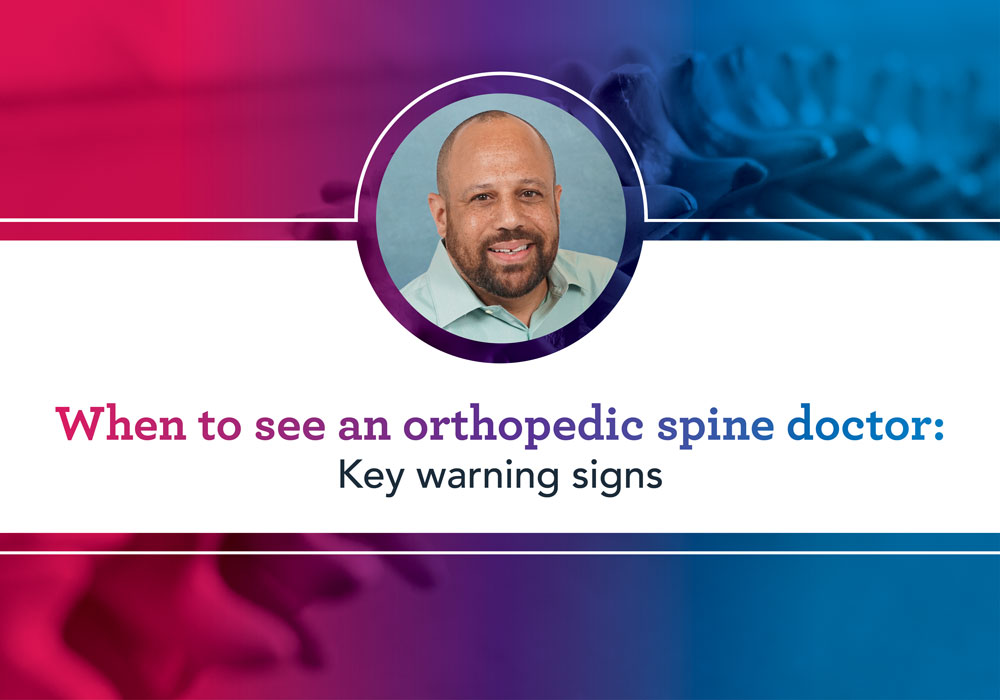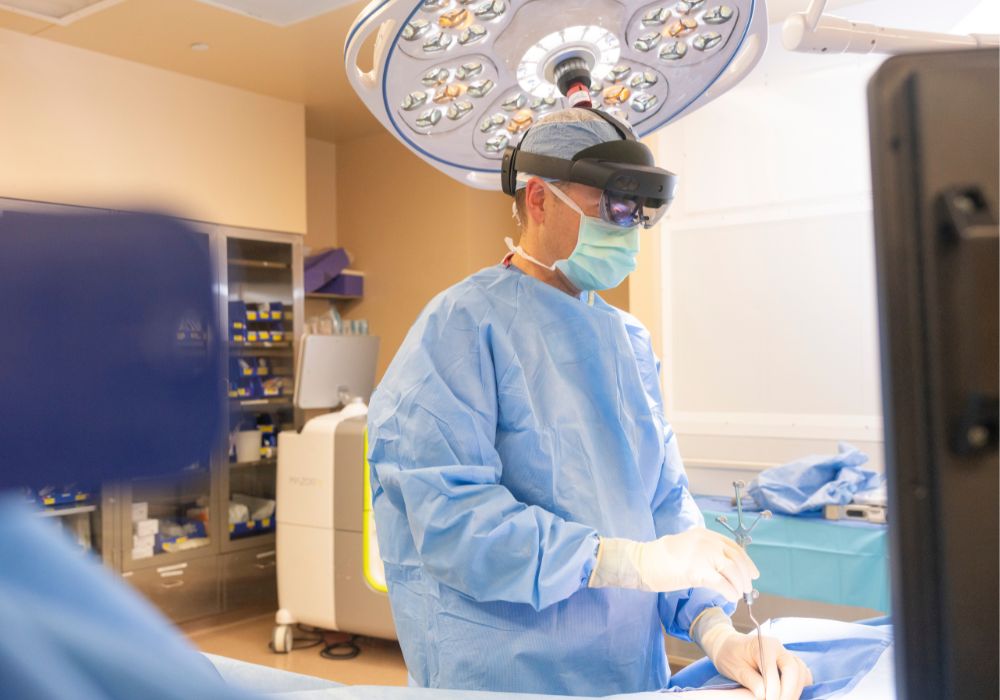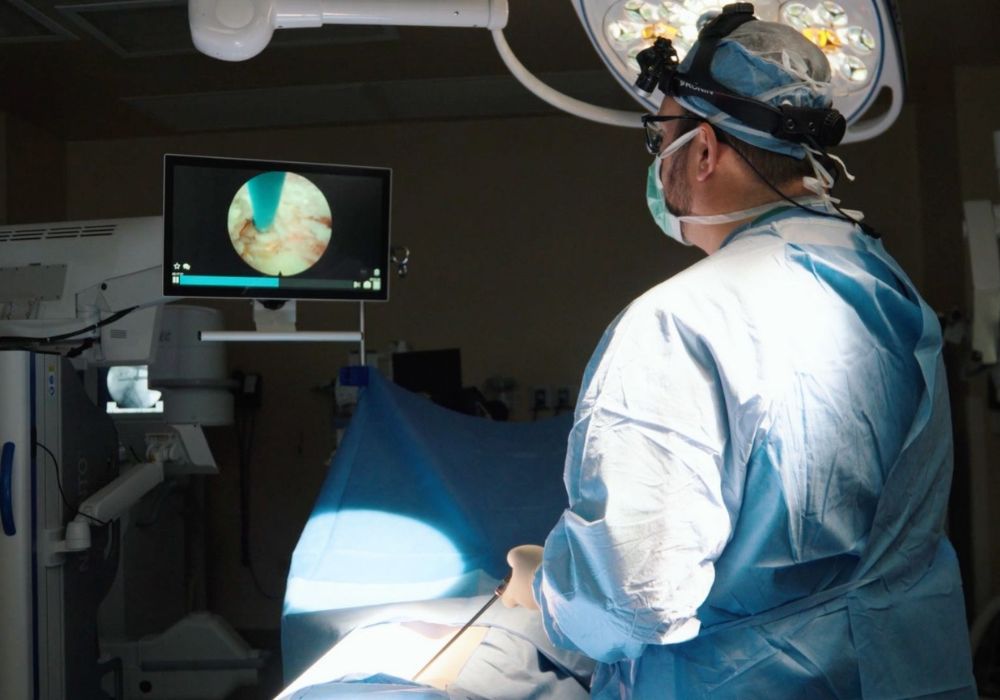Endoscopic spine surgery can be a great alternative to traditional back surgery because it comes with various benefits. But when is this procedure the right choice—and for whom?
Read on to learn more about the conditions treated using endoscopic spine surgery. Plus, discover how to know if you might be a good candidate and how to find a surgeon you can trust to perform this surgery and help you feel better.
What is endoscopic spine surgery?
Endoscopic spine surgery is a minimally-invasive surgical treatment used to relieve chronic pain, numbness, and sciatica caused by disc herniations, spinal arthritis and stenosis.
In endoscopic spine surgery, the surgeon accesses the spinal column through a small opening placed through a small incision less than one centimeter long. The opening creates a small path for an endoscope to reach the spine and repair damaged or diseased disc tissue
An endoscope is a thin tube just a few millimeters wide equipped with a high-resolution camera lens and a powerful light source to allow surgeons to see exactly what they’re doing as they operate clearly.
The endoscopic camera projects the images onto a monitor so the surgeon can visualize the area, and small surgical tools are inserted to remove any bone spur, thickened ligament or herniated disc material.
When the procedure is done, the surgeon removes the instruments and closes the incision with sutures.
Endoscopic spine surgery can be performed to treat lower back pain causes and sciatica due to the following conditions:
- Spinal stenosis
- Spinal arthritis
- Foraminal stenosis
- Degenerative disc disease
- Lumbar disc herniation
- Facet syndrome
What are the advantages of minimally-invasive surgery over traditional surgery?
Traditional back surgery methods disrupt more tissues and muscles, creating more areas that will ultimately need to heal. This means more pain for a more extended period after surgery.
Most patients who undergo endoscopic spine surgery have better outcomes because a surgeon uses this minimally-invasive technique to disrupt fewer tissues and muscles during the procedure.
When compared to traditional spine surgery, a patient’s experience often includes:
- Shorter surgery
- Less pain
- Lower risk of infection
- Less blood loss
- Shorter hospital stay (most patients go home within 24 hours)
- Little to no need for narcotic pain medication
- Faster recovery time
Traditional surgical techniques also cause more damage to the paraspinal muscles, which are the muscles that help you lean to the side, twist and bend forward and backward. Because endoscopic spine surgery techniques don’t cause damage to these frequently-used muscles, recovery will be easier for most people.
In many cases, endoscopic spine surgery can permanently treat your spine condition and relieve pain. However, some patients may require additional surgery for more serious, degenerative spinal conditions.
What makes you a good candidate for endoscopic spine surgery?
Most patients who qualify for endoscopic spine surgery have been diagnosed with one of the common spine conditions listed above and non-surgical treatments have been unsuccessful. They’ve typically been experiencing back pain, numbness or weakness down the arm, leg or around the chest.
Some high-risk patients with increased medical risks can benefit from endoscopic spine surgery, as it is minimally invasive and anesthesia is not always required. This opens up an opportunity for certain patients to get a treatment that may not have been available to them before.
Endoscopic spine surgery may be a promising treatment option if the patient is considered a good candidate for outpatient surgery. This minimally invasive back surgery technique can also be an option to consider for patients who have had unsuccessful traditional spinal surgery in the past.
How do I choose the right spine surgeon?
It’s crucial to find a surgeon who specializes in your condition and is trained in endoscopic spine surgery. If spine surgery is performed incorrectly, you could end up needing multiple corrective surgeries to fix the mistake. Or worse, you could suffer from lifelong pain or complications.
Board-certified, fellowship-trained orthopedic surgeons are the most highly skilled in the field, as fellowship training is the highest degree of training for orthopedic surgeons.
Because of their required ongoing education, board-certified orthopedic surgeons are more up-to-date on the latest literature and best practices. They’re better equipped to perform the latest minimally-invasive spine surgery techniques, like those used in endoscopic spine surgery.
OrthoIndy is a top hospital for spine surgery
If you’re considering endoscopic spine surgery, look for a place where you can get the full spectrum of care, from the hospital to aftercare. OrthoIndy has an award-winning team of specialists who help patients rehabilitate and recover faster with less pain after surgery.
OrthoIndy has been named one of the best hospitals for spine surgery and is in the top 5% in the nation. We are proud to be a Five-Star Recipient for the 2021 Spine Surgery Excellence Award™.
You can schedule online or call us to set up an appointment with one of our orthopedic specialists.
Get a second opinion at OrthoIndy
OrthoIndy has been named one of the best hospitals for spine surgery and is in the top 5% in the nation. We are proud to be a Five-Star Recipient for the 2021 Spine Surgery Excellence Award™.
If you’re struggling with back pain or are looking for a second opinion about getting a lumbar laminectomy, schedule online or call us to set up an appointment with one of our orthopedic specialists.
If your injury or condition is recent, you can walk right into one of our OrthoIndy Urgent Care locations for immediate care. For rehabilitation and physical therapy, no referral is needed to see one of our physical therapists.





